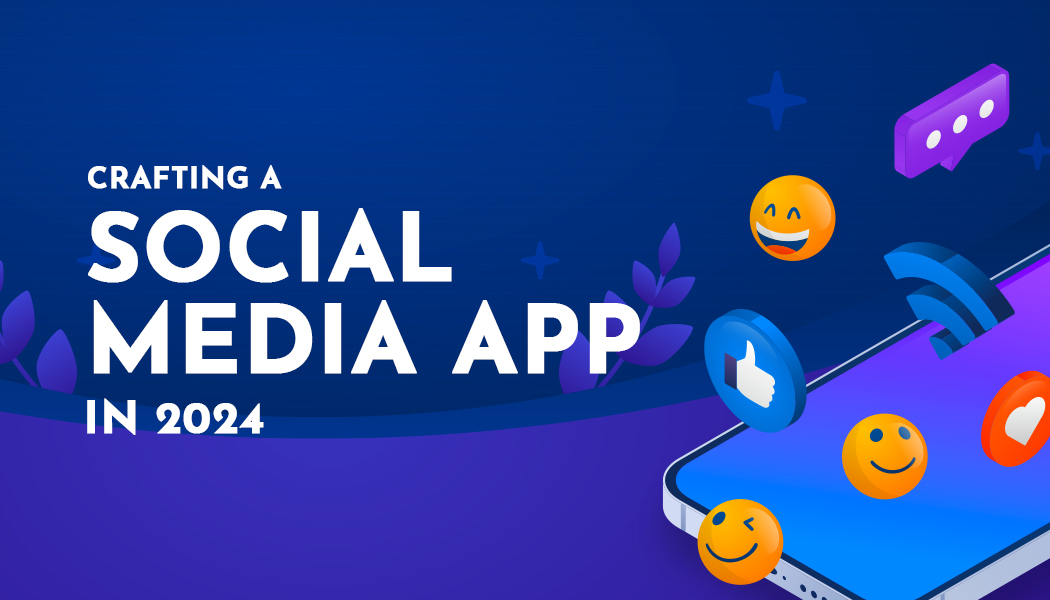Crafting a Social Media App in 2024
As we navigate through the current cyberspace, the urge to create a social media app that resonates with users grows stronger. In this post, you’ll find valuable insights and strategies that’ll help you find an answer to the question: how to start a social media site in 2024?
Market Prospects for Social Media Apps
Understanding the landscape of social media app development requires a deep comprehension of the constantly shifting market dynamics. Each type of social media platform caters to distinct user needs, shaping experiences and defining competition. Let's unravel the categories of social media apps to illuminate your path towards app creation.
-
Social networks like Facebook and LinkedIn are leading the selection. As digital hubs, these platforms facilitate professional connections on LinkedIn and social interactions on Facebook, boasting features like status updates and group discussions for versatile user engagement
-
Media-sharing networks, like Instagram and Snapchat, prioritize seamless multimedia sharing. From captivating photos to engaging videos, these platforms offer creative outlets for self-expression and community building, with specialized platforms like YouTube focusing on specific content types
-
Blogging and publishing networks like WordPress and Medium provide platforms for content creators to share stories and ideas. Offering customizable templates and analytics tools, they amplify voices and foster personal branding in the digital sphere.
The social media app landscape is diverse and vibrant, teeming with opportunities for innovation and connection. By understanding the nuances of each platform type, you can tailor your development strategy to meet user needs and carve out a distinct presence in this dynamic ecosystem.
Key Features of Social Media Apps
Navigating social media app development demands careful consideration of feature selection and their impact on costs. Whether you're creating a minimal viable product (MVP) for initial feedback or incorporating advanced functionalities to captivate users, each feature shapes the app's experience and determines its success.
Let's explore the essential features that lay the foundation for a compelling social media app.
Seamless sign-up processes and immersive newsfeeds drive user engagement, while user-profiles and robust search capabilities enable connections and content discovery. Chat functionalities foster real-time communication and community growth, while posts and push notifications ensure sustained user engagement and retention.
But the journey doesn't end there. To differentiate your app, consider integrating advanced features that enhance user interaction. Augmented reality (AR) filters and advanced editing tools provide creative outlets, while location-based content personalizes the experience. These enhancements boost engagement and establish your app as an innovative leader.
However, developing these features requires careful planning and investment. From backend development to platform-specific coding, meticulous execution is crucial. Admin panel implementation, design considerations, and post-release marketing efforts contribute to development costs and ongoing success.
Cost of Social Networking App Development
As you embark on the exciting journey of bringing your social networking app to life, understanding the financial roadmap ahead is crucial. Each feature, from foundational basics to cutting-edge innovations, influences the investment required to turn your vision into reality.
Let's break down the key elements influencing the cost of social networking app development:
-
Core features: These fundamental functionalities, including user authentication, profiles, newsfeeds, and chats, form the backbone of your app's functionality. With a combined development time of 787 hours across backend, iOS, and Android platforms, implementing these features requires an investment of $118,050 for a single platform and $196,750 for both iOS and Android
-
Advanced feature: Features like AR filters, editing tools, and location-based content inject dynamism and engagement into your app. Although requiring relatively shorter development times of 14 hours each, these elements significantly contribute to the sophistication and allure of your platform.
-
Admin panel: Serving as the nerve center of your application, the admin panel empowers you to manage user activities, monitor performance, and analyze data. With a development timeline of 140 hours and consistent costs across platforms, the admin panel ensures seamless operation and oversight of your social networking realm.
-
Integration of frameworks and libraries: Harnessing the power of frameworks and libraries enhances functionality and user experience, enabling features such as push notifications and multimedia sharing. With a development period of 14 hours for integration, these tools optimize performance and user engagement.
-
UI/UX design: The visual appeal and user-centric design of your app are pivotal in captivating and retaining users. Devoting 196 hours to UI/UX design ensures intuitive layouts, seamless navigation, and visually stunning interfaces, guaranteeing a memorable and immersive user journey.
-
Quality assurance, DevOps, and project management: Upholding the reliability, security, and efficiency of your app demands dedicated efforts in quality assurance, DevOps, and project management. With a combined development time of 282 hours, these facets ensure smooth deployment, ongoing maintenance, and effective project coordination.
Building a Social Media App: Tech Stack, Team, and Development Steps
Crafting your own social media app requires more than just a vision – it demands a carefully curated team and a strategic roadmap for development. Let's delve into the essential components of assembling the right crew, selecting the perfect tech stack, and navigating through the labyrinth of development steps.
Team Composition
-
Project manager: The orchestrator of the development process, ensuring timelines are met and resources are optimized
-
UI/UX designer: The creative force behind intuitive interfaces and captivating user experiences
-
iOS developers: Experts in Swift, crafting the iOS version of your app with finesse and precision
-
Android developers: Proficient in Kotlin, bringing the Android version of your creation to life
-
Back-end developer: The architect of your app's digital infrastructure, utilizing Node.js and Express to build server-side logic and database functionality
-
QA engineer: The guardian of quality, rigorously testing every aspect of your app to ensure a seamless user experience.
Tech Stack
-
iOS app development: Swift for the programming language and Alamofire for networking
-
Android app development: Kotlin for the programming language and OkHttp 3 for networking
-
Back-end development: Node.js for the programming language, Express 4 for the framework, MySQL for the database, and a variety of tools like Socket.io for chat and Amazon SES/SNS for signup. Additionally, a suite of tools, including FCM for push notifications, Google Maps for geolocation, Amazon S3 for storage, Elastic Email for emails, Elastic search for search, and ML Kit/ARCore for AR filters, can enhance your app's functionality.
Development Process
-
First contact: Reach out to a development company to discuss your project's goals and requirements
-
Discovery phase: Business analysts gather insights and create a blueprint for your app's development, including detailed documentation and wireframes
-
UI/UX design: Designers bring concepts to life, creating sleek mockups that embody your app's identity and functionality
-
Development: Developers begin coding, breaking down tasks into sprints for efficient progress and translating designs into digital reality
-
Quality assurance: QA engineers conduct rigorous testing to ensure your app is bug-free and provides a seamless user experience
-
Release and maintenance: With final touches applied, your app is ready for launch, and ongoing updates and maintenance ensure its continued success.
Monetization Models for Social Media Apps
Creating a social media app is just the beginning – making it profitable is the ultimate goal. You must explore various monetization strategies tailored to your app's audience and niche to achieve this. Let's explore three popular monetization models:
-
Advertisements: Ads are the primary revenue stream for social media platforms. By integrating ads into your app, you can offer it to users for free while generating income through ad placements. For example, Instagram incorporates sponsored posts and stories into users' feeds, ensuring relevance and engagement
-
Premium features: Offering premium subscriptions is another lucrative avenue for monetizing social media apps. Platforms like YouTube and LinkedIn entice users with premium memberships, granting access to exclusive features and perks
-
In-app purchases: Integrating in-app purchases allows users to unlock additional content or features for a fee, adding another monetization layer to your app. Facebook, for example, offers a sticker store within the Messenger app, where users can purchase and use their favorite sticker packs to personalize their conversations.




